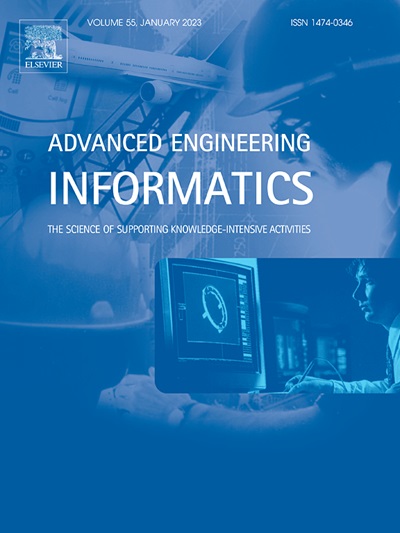基于图形的系统的系统架构,支持维护道路基础设施的多尺度数字孪生
IF 9.9
1区 工程技术
Q1 COMPUTER SCIENCE, ARTIFICIAL INTELLIGENCE
引用次数: 0
摘要
道路基础设施是一个由多个相互作用的子系统组成的复杂系统。全面了解各种道路基础设施要素之间的相关性和依赖性对于加强基础设施管理和维护至关重要,为决策支持提供了坚实的基础。数字孪生(DT)被认为是促进此类决策的有效工具。然而,考虑到道路基础设施整体的综合道路交通的发展仍处于早期阶段。因此,本文着重于道路基础设施的数字表示的概念化,该表示能够评估各种异构子系统之间的关系。为此,我们将系统的系统原理应用于道路基础设施。其核心是使用标记属性图(LPG)来捕获子系统内部关系和系统间联系,从而促进交互的整体表示。此外,我们承认分布式责任的当前组织状态导致使用联邦数据库的概念进行分布式数据存储和维护。所提出的方法能够对道路基础设施要素之间的关系进行多尺度评估,同时保持系统的可扩展性和基础设施数据的分布式管理。因此,以前单独的数据集可以在大范围内相互评估。这样,所提出的概念为不同异构基础设施数据集之间的广泛相关性研究提供了基础。通过将该概念应用于来自多个巴伐利亚道路管理部门的大规模真实数据集,将其转换为拟议的图结构,并通过跨域查询和分析展示所获得的功能,从而验证了该概念。本文章由计算机程序翻译,如有差异,请以英文原文为准。

A graph-based systems-of-systems architecture enabling multi-scale Digital Twins for maintaining road infrastructure
Road infrastructure constitutes a complex system characterized by multiple interacting subsystems. A comprehensive understanding of the correlations and dependencies among various road infrastructure elements is essential for enhancing infrastructure management and maintenance by providing a robust foundation for decision support. Digital Twins (DT) are recognized as effective tools for facilitating such decision-making. However, the development of comprehensive DTs considering road infrastructure in its entirety is still in its early stages. Hence, this paper focuses on the conceptualization of a digital representation of road infrastructure that enables the evaluation of relationships between the various heterogeneous subsystems. To accomplish this, we apply the systems-of-systems principle to road infrastructure. At its core, Labeled Property Graphs (LPG) are employed to capture intra-subsystem relationships and inter-system linkages, facilitating a holistic representation of interactions. Furthermore, we acknowledge the current organizational status of distributed responsibilities resulting in distributed data storage and maintenance by using the concept of federated databases. The presented approach enables multi-scale evaluations of relations among road infrastructure elements while preserving the system’s scalability and the distributed management of infrastructure data. Thus, previously separate data sets can be evaluated in relation to each other on a big scale. Doing so, the presented concept provides a foundation for extensive correlation studies between different heterogeneous infrastructure datasets. The concept is validated by applying it to a large-scale real-world data set stemming from multiple Bavarian road authorities, transferring into the proposed graph structure, and demonstrating the gained capabilities through cross-domain queries and analysis.
求助全文
通过发布文献求助,成功后即可免费获取论文全文。
去求助
来源期刊

Advanced Engineering Informatics
工程技术-工程:综合
CiteScore
12.40
自引率
18.20%
发文量
292
审稿时长
45 days
期刊介绍:
Advanced Engineering Informatics is an international Journal that solicits research papers with an emphasis on 'knowledge' and 'engineering applications'. The Journal seeks original papers that report progress in applying methods of engineering informatics. These papers should have engineering relevance and help provide a scientific base for more reliable, spontaneous, and creative engineering decision-making. Additionally, papers should demonstrate the science of supporting knowledge-intensive engineering tasks and validate the generality, power, and scalability of new methods through rigorous evaluation, preferably both qualitatively and quantitatively. Abstracting and indexing for Advanced Engineering Informatics include Science Citation Index Expanded, Scopus and INSPEC.
 求助内容:
求助内容: 应助结果提醒方式:
应助结果提醒方式:


